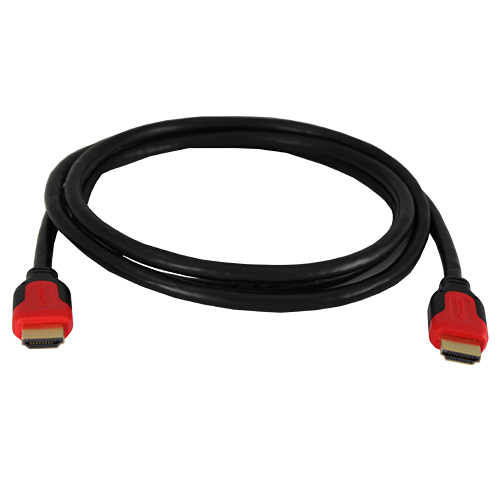Why Use HDMI Cables?
Published on 30 December 13
2224
1
With the soaring popularity of HDTV and the digitization of almost all forms of entertainment, more and more people are using HDMI cables to make transmission seamless and effortless. But you must be wondering what is HDMI exactly?
What is HDMI?
HDMI stands for High Definition Multimedia Interface. HDMI is a global standard established by a slew of electronics brands such as Panasonic, Sony, Philips, Toshiba, and others. HDMI was developed to establish a foundation for transmitting HD videos and multichannel audio. More than 800 companies are now using HDMI technology for their products and components.
With the rise of HDMI technology, users will now experience an all-digital solution, single cable, and high quality transmission when they connect audio and video components to each other. Using an HDMI cable will limit the need for reconfiguring analog to digital and vice-versa. The two-way nature of HDMI allows users to connect different audio and video components no matter what their brand is. With HDMI, components can interact with each other and share necessary digital information for efficient transmission through multiple components.
What are the benefits of using an HDMI cable?
There are multiple benefits to using an HDMI cable. One of the benefits of using a cable is that it provides users with an all-digital signal transfer. With this type of cable, you can connect different components to each other regardless of manufacturer or brand. Older types of cables need multiple cables and connections for video and audio components. With HDMI, a user no longer has to go through digital to analog and vice-versa processes. The information stays in its digitized form which allows it to go through just one HDMI connector.
With HDMI technology, you only need to use one cable when your component transmits multiple audio signals. Before the development of HDMI connectors, users would have to use at least one audio cable and up to three video cables for one component. By using HDMI all the digital information goes through one single cable. Home entertainment components mostly use HDMI connectors because it is less messy and confusing to use.
What should you look for when buying an HDMI cable?
Before you purchase an HDMI cable, there are a few things that you should take note of. Not all HDMI connectors are created equally there are cables that provide better performance and audio and video quality. When looking for a cable, consider its construction and the materials used for it. Take note of conductor thickness, insulation, quality of shielding, and specific features. You must also consider speed rating. Choose a cable that provides at least 10.2Gbps. With a speed rating of at least 10.2Gbps, your connector can transmit HD signals up to 1080p resolution. Higher speed ratings provide higher bandwidth and allow it to support additional audio, intercommunication, and video features. Look for a cable that supports the features that your components have. If you are in Australia you can buy HDMI cables for as low as $5.95 from www.proaudiovisual.com.au/hdmi-cable
How will you know how many cables will you need to use?
The number of cables you need to use will depend on how many HDMI compatible products you are using, the outputs and inputs of the components you are using, and the configuration of the equipment you have. If your components are all HDMI compatible and have the right number of outputs and inputs, all you will need is one HDMI connector.

What is HDMI?
HDMI stands for High Definition Multimedia Interface. HDMI is a global standard established by a slew of electronics brands such as Panasonic, Sony, Philips, Toshiba, and others. HDMI was developed to establish a foundation for transmitting HD videos and multichannel audio. More than 800 companies are now using HDMI technology for their products and components.
With the rise of HDMI technology, users will now experience an all-digital solution, single cable, and high quality transmission when they connect audio and video components to each other. Using an HDMI cable will limit the need for reconfiguring analog to digital and vice-versa. The two-way nature of HDMI allows users to connect different audio and video components no matter what their brand is. With HDMI, components can interact with each other and share necessary digital information for efficient transmission through multiple components.
What are the benefits of using an HDMI cable?
There are multiple benefits to using an HDMI cable. One of the benefits of using a cable is that it provides users with an all-digital signal transfer. With this type of cable, you can connect different components to each other regardless of manufacturer or brand. Older types of cables need multiple cables and connections for video and audio components. With HDMI, a user no longer has to go through digital to analog and vice-versa processes. The information stays in its digitized form which allows it to go through just one HDMI connector.
With HDMI technology, you only need to use one cable when your component transmits multiple audio signals. Before the development of HDMI connectors, users would have to use at least one audio cable and up to three video cables for one component. By using HDMI all the digital information goes through one single cable. Home entertainment components mostly use HDMI connectors because it is less messy and confusing to use.
What should you look for when buying an HDMI cable?
Before you purchase an HDMI cable, there are a few things that you should take note of. Not all HDMI connectors are created equally there are cables that provide better performance and audio and video quality. When looking for a cable, consider its construction and the materials used for it. Take note of conductor thickness, insulation, quality of shielding, and specific features. You must also consider speed rating. Choose a cable that provides at least 10.2Gbps. With a speed rating of at least 10.2Gbps, your connector can transmit HD signals up to 1080p resolution. Higher speed ratings provide higher bandwidth and allow it to support additional audio, intercommunication, and video features. Look for a cable that supports the features that your components have. If you are in Australia you can buy HDMI cables for as low as $5.95 from www.proaudiovisual.com.au/hdmi-cable
How will you know how many cables will you need to use?
The number of cables you need to use will depend on how many HDMI compatible products you are using, the outputs and inputs of the components you are using, and the configuration of the equipment you have. If your components are all HDMI compatible and have the right number of outputs and inputs, all you will need is one HDMI connector.

This review is listed under
Peripherals
Community
Related Posts:

 Kristen
Kristen



HDMI cabel are required of viewing high quality pictures. Technicaly speaking about HDMI cables. Everyone must know this who uses HDMI cables because, clarity wise it will be helpful . deals15.com